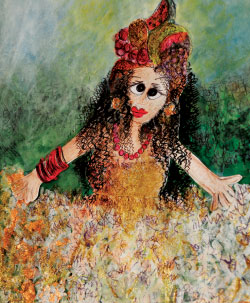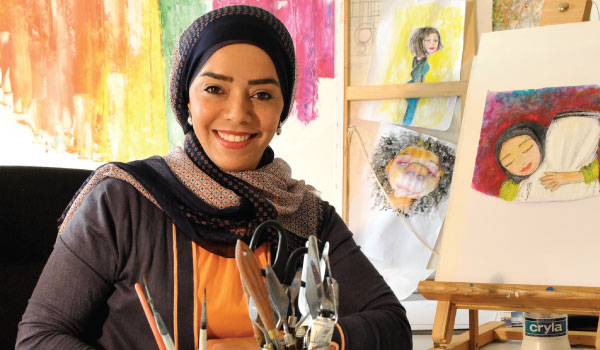Art is typically emotive, but for Hanadi Al Ghanim, it is about more than just self-expression.
As any art-lover will tell you, one of the most beautiful things about standing in front of a painting or a photograph is trying to imagine what the subject or the artist was feeling at the time. For the viewer, art is a portal into somebody else’s world.
Never was this statement more true than for Hanadi Al Ghanim. It is Hanadi’s theory that language only gets us so far. “Sometimes our language does not help us to capture what happens inside ourselves”, she explains. “Sometimes, when you are trying to express yourself, you can feel as if you are inside a swimming pool or in water. You speak, but no sound comes out,” she continues.
It is this metaphor which inspired some of Hanadi’s recent work. Last year she exhibited a video piece which portrays her in swathes of white material, submerged in a pool of water, surrounded by a collection of individual letters and Arabic characters that fail to spell out any meaning.
 Owing to the idea that words and language often fall short of conveying the essence of true meaning, Hanadi views her art work as her personal form of conversation, not just with her viewing public, but also with herself. “My art is not only to mix colours,” she says. “It is my feelings. You look at my art and you know what I am feeling. My art is the same as a conversation; I talk with my art and with my painting,” she continues.
Owing to the idea that words and language often fall short of conveying the essence of true meaning, Hanadi views her art work as her personal form of conversation, not just with her viewing public, but also with herself. “My art is not only to mix colours,” she says. “It is my feelings. You look at my art and you know what I am feeling. My art is the same as a conversation; I talk with my art and with my painting,” she continues.
As well as her videos and her abstract paintings, Hanadi sketches a series of female characters. These characters are at one time the generic Bahraini female and a depiction of herself. “She is Bahrain and she is also me,” explains Hanadi. I look at one particular mixed media portrayal of a woman, staring through an open window with a wistful expression on her face and I ask her what it means. “Her face is saying, ‘Don’t think I am always thinking about you’, but she is lying,” Hanadi concludes. The picture, especially with this added explanation, is more than a little bit charming. I discover, as I sit and talk to Hanadi and we go through her work, that love and waiting are two of the more prevalent and consistent themes.
It is certainly these two words which have inspired her most recent creation. Hanadi’s work has been on display in Bohemia gallery in Adliya, as part of the Al Riwan 338 exhibition, during the Spring of Culture. This latest offering consists of another video installation, depicting an ethereal scene in which an Arab woman, turned towards the camera, smiles at, locks eye contact with and hugs an anonymous Arab man who is dressed in a white thobe.
“The hug is the important part of this, not really the nature of the relationship between the two people. You cannot live your life without hugs between you and somebody you love. It doesn’t have to be a boyfriend or husband. Just someone with whom there is mutual feeling,” Hanadi explains. “On a bigger level, Bahrain needs a hug. We need to pull everybody together so that Bahrain is unified,” she continues.
I find it interesting that Hanadi seems to have so many different personal styles. There really isn’t one aesthetic that you could charge her with sticking to. Clearly, though, she has a passion for video art. I ask her to explain this to me. “Videos allow you to feel different things to paintings,” she says. “You can have movement inside your work. You can hear sounds and follow the movements. It involves so many senses,” she continues. “I also believe that artists should keep up with the times.
These days, you won’t find many people who are prepared to stand in front of a painting for hours deciding what they feel.
Now, they want to get the idea and then ‘halas’, they go. With video art, anyone can be a viewer. I can send it by email or on my phone to the people who don’t have time to visit the exhibition. Art should reflect the current times,” Hanadi explains.
The way we view art is evolving and so is our definition of the term “artist”. This is evident in the location of Hanadi’s latest exhibition. Bohemia isn’t your typical gallery. It is a run down ex-restaurant, where the artists have been given a licence to scrawl all over the walls, commandeer their own rooms and create their own lighting systems. It is interactive and malleable and involving. “Many people are artists these days. And there is room for everybody. We all have an artist inside of us,” Hanadi proclaims.
As is clear in her work, Hanadi is always looking for a medium to convey a message — some profound, others wistful. True to type, she would like to leave the readers of this article with a couple of thoughts. The first is a metaphor about life’s goals: “If you want something, think of a map. Put a pin in what you want and find the straightest route there from where you are”. The second is simpler: “Don’t wait for somebody to make you happy. Your happiness comes from yourself.”


































